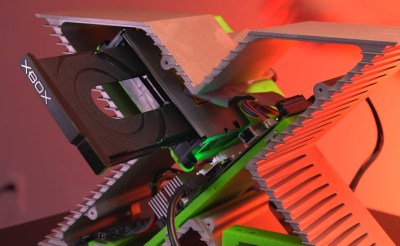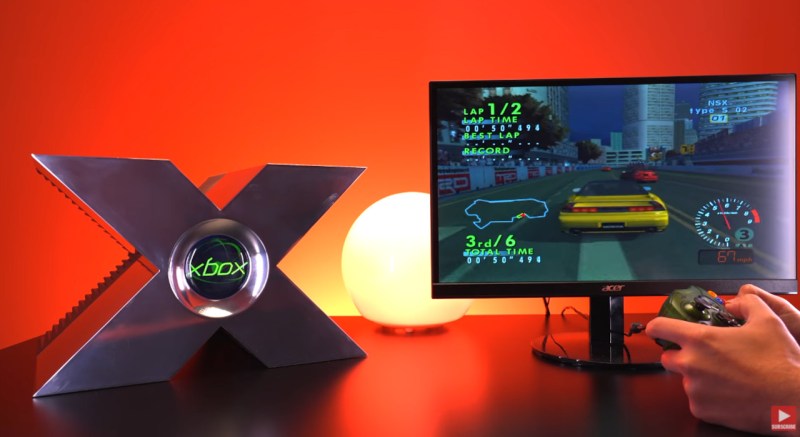When Microsoft decided they wanted to get into the game console market, they were faced with a problem. Everyone knew them as a company that developed computer software, and there was a concern that consumers wouldn’t understand that their new Xbox console was a separate product from their software division. To make sure they got the message though, Microsoft decided to show off a prototype that nobody could mistake for a desktop computer.
The giant gleaming X that shared the stage with Bill Gates and Seamus Blackley at the 2000 Game Developers Conference became the stuff of legend. We now know the machine wasn’t actually a working Xbox, but at the time, it generated enormous buzz. But could it have been a functional console? That’s what [Tito] of Macho Nacho Productions wanted to find out — and the results are nothing short of spectacular.
The key to this project is the enclosure itself, but this is no simple project box we’re talking about here. Milled from a solid block of aluminum, the original prototype’s shell reportedly cost Microsoft $18,000 to have produced, which would be around $36,000 when adjusted for inflation. Luckily, the state of the art has moved forward a bit in the intervening two decades. So after working with [Wesk] to create a 3D model from reference images (including some that [Tito] took himself of one of the surviving prototypes on display in New York), the design was sent away to PCBWay for production. It still cost the better part of $6 K to be produced, but that’s a hell of a savings compared to the original. Though [Tito] still had to polish the aluminum himself to recreate the original’s mirror-like shine.
 To say the rest of the project was “easy” would be something of an understatement, but it was at least more familiar territory. Unlike the original prototype, this machine would actually play Xbox games, to [Tito] focused on cramming the original era-appropriate hardware (plus a few modern homebrew tweaks, such as HDMI-out) into the hollow X using a clever system of integrated rails and 3D printed mounts.
To say the rest of the project was “easy” would be something of an understatement, but it was at least more familiar territory. Unlike the original prototype, this machine would actually play Xbox games, to [Tito] focused on cramming the original era-appropriate hardware (plus a few modern homebrew tweaks, such as HDMI-out) into the hollow X using a clever system of integrated rails and 3D printed mounts.
Some of the original parts, like the power supply, were simply too large to use. That’s where [Redherring32] came in. He designed a custom USB-C power supply that could satisfy the original console’s energy needs in a much smaller footprint. There’s also a modern SSD in place of the 8 GB of spinning rust that the console shipped with back in 2001. But overall, it’s still real Xbox hardware — no emulation or other funny tricks here.
At this point, the team had already exceeded what Microsoft pulled off in 2000, but they weren’t done yet. Wanting to really set this project apart, [Tito] decided to replace the center jewel with something a bit more modern. The original was little more than a backlit piece of plastic, but on this build it’s a circular LCD driven by a Raspberry Pi Pico, capable of showing a number of custom full-motion animations thanks to the efforts of [StuckPixel].
The end result of this team effort is a machine that’s not only better looking than Microsoft’s original, but also more functional. It’s a project that’s destined for a more than just sitting on a shelf collecting dust, so we’re happy to hear that [Tito] plans on taking it on a tour of different gaming events to give the public a chance to see it in person. He’s even had a custom crate made so he can transport it around in style and safety.
















Beautiful! Really detailed work. A tip of the hat to all concerned.
Idle speculation… how close was the original Xbox motherboard form-factor to standard (ITX or microATX)? I wonder if the enclosure could be repurposed in due course to accept a more modern board, perhaps then running XEmu or MAME…?
It’s not at all close other than being a rectangle sure you can do it pretty sure people have but its not a drop in clear some holes affair
Nirvana’s single “X-shaped box” didn’t A/B test very well, so they changed the name.
$18k ea. was for the whole functional prototypes, not just the shell.
A billet of aluminum that size would be about 80 kg, costing about $200 at the time. Milling it would cost $$$, or even $$$$, but certainly not $$$$$
I love The Duke style controller still to this day. I know I’m in the minority, but it fit my hands so well.
That is a stellar example what can be done nowadays by virtually everyone. Of course it’s a quite expensive project, but just, like, 15 years ago, this would be virtually impossible to pull off, I think.
I realize that 15 or 20 years is quite a long time, but when you started your “maker adventures” before the advent of flashable microcontrolles, no real access to any parts or information about parts and manufacturing capabilities defined by hand saws, drill presses and metal files, this all almost feels like science fiction.
From that POV I’d really love to be like 15 or 16 years old right now, to really have the time to use all the new possibilities….